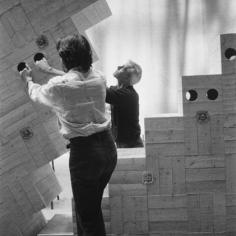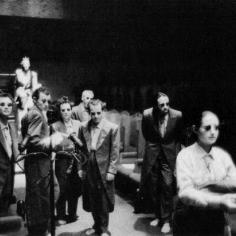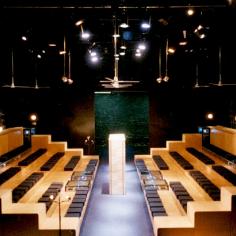1996 · Brancusi contre États-Unis · Vigner (EN)
"Flying has occupied my mind as long as I live."
BRANCUSI
In 1996, Éric Vigner produced BRANCUSI CONTRE ÉTATS-UNIS (A historic lawsuit - 1928), which he adapted for the 50th Anniversary of the Avignon Festival for a presentation in the Conclave Hall of the Papal Palace, with PIERRE BAUX, ODILE BOUGEARD, PHILIPPE COTTEN, DONATIEN GUILLOT, ARTHUR NAUZYCIEL, VINCENT OZANON, LAURENT POITRENAUX, MYRTO PROCOPIOU, ALICE VARENNE. The play was subsequently restaged for the Centre Georges Pompidou in Paris, the pithead of a mine at Forbach, the Tribunal of Pau and at the CDDB-Théâtre de Lorient.
The Brancusi case dealt with the question of what was a work of art in the eyes of an American customs officer in the Port of New York towards the end of the 1920s. This was the question an American court had to decide in a lawsuit that was to become famous, with Brancusi filing suit against the US Customs Service. One of Brancusi’s works, “Oiseau” (The Bird) had not been recognised as a work of art by a customs officer who levied a 40% ad valorem duty on it upon entry on US territory, the rate applicable to all sorts of manufactured products, while works of art were deemed exempt from customs payment. The sculptor sued the American administration and won.
Q : You said that the Exhibit 1 is a work of art and in your opinion represents a bird that is flying ?
A : No, not that it represents a bird, but it does suggest, is has the qualities of suggesting a flying bird, suggesting the flight of a bird. It does not represent a bird.
Q : It does not represent a bird ?
A : No.
Q : Has the same quality of representing a fish ?
A : No.
Q : If it was called a fish ?...
A : Not what it is called, only it gives you the feeling. Not because it is called a bird, but because it does suggest the quality of flight.
Q : That is the only thing that makes it a work of art ?
A : No, the form, the balance, the beautiful sense of workmanship, and the pleasure that it gives me to look at it.
Q : You get the same amount of pleasure from any beautiful highly polished piece of metal ?
A : No sir.
"The word ‘bird’ did not have the same meaning for the counsel for the defence as it had for plaintiff. For the one it meant a flying object, for the other it constituted the very essence of flight. In the Brancusi trial, the testimony of different players was couched in the same words, but the tone of voice was different and so was the emotional content. The meaning as such was not enough. When testifying they testified to different things. On stage, I am not interested in meaning, not at all. What interests me is the language, the writing, as poetic material - the word per se. … It is not meaning that we are concerned with: what we work with is the tone of voice, what we search for is the moment when the tone makes sense."
ÉRIC VIGNER
"Witnessing a trial that by its very nature is charged with theatricality, where time does justice to the artist in question, requires of the modern spectator radical self-searching, forces him or her to probe their ability to react to something new. In this way, the theatre gives rise to a debate about the essence of things."
Georges Banu, Art-Presse, December 1996
"A trial. A confined space in which sit an areopagus of sages whose calling it is to decide what is, and what is not, a work of art. As always and everywhere, two words, two worlds, two truths face each other. Unable to communicate: Knowledge and Knowing. And then, as though sliding down an inclined plane, “The Bird” dematerialises and scatters into space, while the spoken word expands and assumes a bodily form somewhere else, in the field of sound. It is a forum, a public space, where the Conference of Birds meets, where the actors, like the angels in Wim Wenders’s ‘The sky above Berlin’ (also known as Wings of Desire), try to redefine the rules that govern the functioning of the world by the redefining the word. It is all about the wind, about flying, about the flight of feelings. The question is about the word that participates in the creation of the world. As one invents the world by inventing the word. The question is how dramatic art can do justice to it. A working hypothesis !"
BÉnÉdicte Vigner
© Photography : Alain Fonteray
Texts assembled by Jutta Johanna Weiss
Translation from the French by Herbert Kaiser
© CDDB-Théâtre de Lorient





